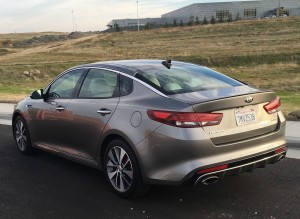Although the Kia Optima went through a redesign this year, don’t look for a major exterior metamorphosis. The significant changes need a little investigative work to be unveiled.
The Kia braintrust initiated changes in the chassis that will be appreciated for a number of reasons. The 2016 Kia Optima features a chassis that is primarily constructed of high-strength steel, The South Korean automaker believes the changes will provide better handling, increase stability at high speeds and add to the structural rigidity.

Need an interpretation of the above? You will enjoy driving the 2016 Optima more than ever before. That’s significant because previous Optima offerings provided a solid ride that rarely drew any noteworthy criticism.
Another change that shouldn’t be overlooked is adding a second turbocharged engine that offers both performance and improved gas mileage. Some interior changes have been made as well.
Despite the changes, there’s no guarantee the Optima will increase in sales, thanks to an extremely competitive field of midsize sedans. The heavy hitters remain the Honda Accord and the Toyota Camry, historical top sellers in the class.
2016 Kia Optima
- Performance: 2.4-liter, four-cylinder, 185 horsepower; turbocharged 1.6-liter, four-cylinder, 178 horsepower; turbocharged 2.0-liter, four-cylinder, 245 horsepower
- Mileage estimate: 22-28 mpg; 28-39 mpg; 22-32 mpg
- Price estimate: $21,840 to $35,790
- Warranty: 5 years/60,000 miles; drivetrain: 10 years/100,000 miles; roadside assistance: 5 years/60,000; corrosion: 5 years/100,000
But the Camry and Accord aren’t alone. The Ford Fusion, Mazda 6, Nissan Altima and Hyundai Sonata are all worthy of a look when shopping for a family-friendly sedan.
If one understands the Kia-Hyundai relationship, it should come as no surprise that the Optima mirrors some of the Hyundai Sonata basic designs.
For those not in the know, Kia and Hyundai do lots of sharing, including factories, engineering, parts and similar testing. Yet the two South Korean companies maintain their own marketing, distribution and styling departments.
The new Optima turbo model is a 1.6-liter, four-cylinder that produces 178 horsepower and 195 pound-feet of torque. Kia pairs the engine with a 7-speed dual-clutch transmission. It outperforms the other two engine options in fuel economy, getting a reported 29-38 mpg.
The existing turbocharged engine – 2.0-liter, four-cylinder with 245 horsepower and 260 pound-feet of torque – is superior in the power department to the new turbo model yet only gets approximately 22-32 mpg.
The third Kia engine is a 2.4-liter, four-cylinder that generates 185 horsepower and 178 pound-feet of torque. It’s not as performance-laden as the turbo models and its gas mileage (between 22-28 mpg) falls short as well.
The 2016 Optima is a little roomier inside than previous models. The front seat is comfortable and passengers will be happy thanks to now having a nearly identical six-way power seat that the driver enjoys. Backseat room is comparable to most competitors.
Kia has given the Optima more soft-touch features and the trunk space has slightly increased to 15.8 cubic feet. The interior makeup is both smart and functions well.
Although its appealing price tag keeps inching upward, so does the overall quality of the Kia Optima. Improved chassis, smart interior changes, and the addition of another turbo engine are all positive additions to the 2016 Optima.
Jeffrey Weidel can be reached at [email protected]. Follow him on Twitter at @jeffweidel. His “Weidel on Wheels” auto reviews are featured periodically on this website at www.tahoeskiworld.com